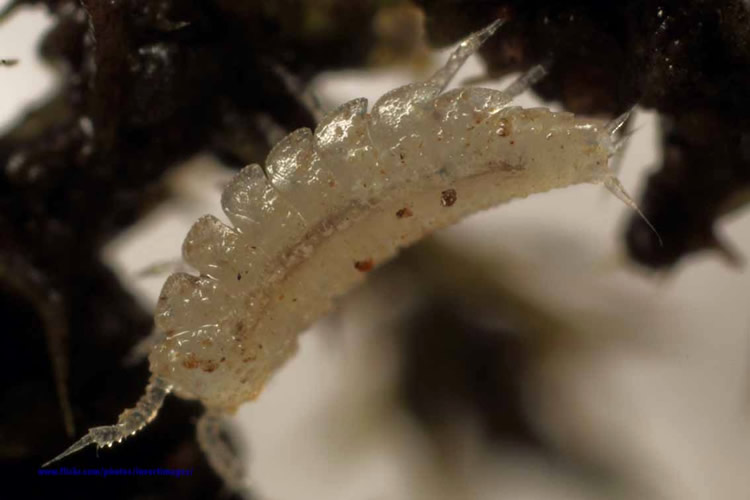Metatrichoniscoides leydigii (Weber, 1880)
Status:
- GB IUCN status: Data Deficient
- GB rarity status: Nationally Rare
ID Difficulty
Identification
Metatrichoniscoides species are very small (up to 2.5 mm long) lacking pigment (white), lacking ommatidia (eyes) and the dorsal surface is covered in coarse tubercles. This is a difficult genus and only male specimens of M. leydigii can be distinguished from M. celticus or preserved (faded) specimens of Trichoniscoides. Identification is made by microscopic examination of male pleopods.
The diagnostic male pleopods of Metatrichoniscoides leydigii are figured in Gregory, (2012), Fig. 1.
Distribution
Metatrichoniscoides leydigii was first discovered in Britain in 1989 in the grounds of a garden centre in Oxford city BISG Newsletter 28, pg. 1). In 2011 a coastal site was discovered in Kent beside the River Medway. This habitat is akin to that noted in the Netherlands, where this species is native, suggesting that it may be an overlooked native species in eastern Britain (Gregory, 2012). Subsequently, it has been recorded from an ornamental garden in Derbyshire (Richards, 2016) and the coast of the Ribble estuary, western England (Hughes, 2020). A updated distribution map is given in Gregory (2024).
Habitat
This elusive pygmy woodlouse occurs in both inland synanthropic habitats (a garden centre and an ornamental garden) where it is likely to have been introduced via the horticultural trade and coastal sites in areas where there has been past industrial activity.
It is a 'soil dwelling' species favouring peaty substrates. The initial Oxford city specimens were found deep among peaty compost accumulated within stones and gravel; that from Derbyshire beneath a large embedded garden slab. The coastal Kent specimen was beneath a stone embedded in peaty soil and in the Ribble estuary specimens where found within pockets of rich humus under firmly embedded rocks along the high tide mark above a dense layer of storm debris.
It has been found associated with other soil dwelling trichoniscids, such as Haplophthalmus mengii, Trichoniscoides albidus and T. sarsi and T. saeroeensis.
This species account is based on that in Gregory (2024).
References
Hughes, T. (2020) The occurrence of Metatrichoniscoides leydigii (Weber, 1880) (Isopoda: Oniscidea) on the Ribble Estuary, Lancashire. Bulletin of the British Myriapod & Isopod Group 32: 56-58.
Richards, P. (2016) A third British site for Metatrichoniscoides leydigii (Weber, 1880). Bulletin of the British Myriapod & Isopod Group 29: 34-36.
Gregory, S.J. (2012) The occurrence of two elusive woodlice, Metatrichoniscoides leydigii (Weber, 1880) and Trichoniscoides sarsi Patience 1908, in semi-natural habitat in Kent. Bulletin of the British Myriapod & Isopod Group 26: 37-40.
Gregory, S. (2009) Woodlice and Waterlice (Isopoda: Oniscidea & Asellota) in Britain and Ireland. Field Studies Council/Centre for Ecology & Hydrology.
Links
World List of Marine, Freshwater and Terrestrial Isopod Crustaceans: https://www.marinespecies.org/isopoda/aphia.php?p=taxdetails&id=261213





